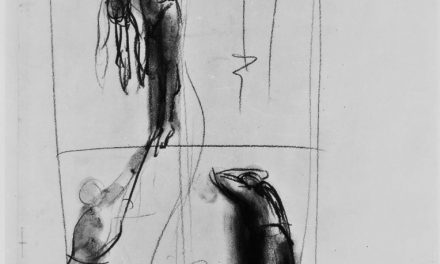 “No, no. That’s not what that is there for.” So exclaim Nim’s teachers as the adolescent Chimp tries *ahem* pleasure himself with a cat. It’s a common expression, something we tell our kids all the time–that is not what that is for. But in the disturbing documentary Project Nim, released last July, this statement takes on striking moral significance.
“No, no. That’s not what that is there for.” So exclaim Nim’s teachers as the adolescent Chimp tries *ahem* pleasure himself with a cat. It’s a common expression, something we tell our kids all the time–that is not what that is for. But in the disturbing documentary Project Nim, released last July, this statement takes on striking moral significance.
Project Nim is the story of Nim Chimpsky, the chimpanzee taken from his mother at only a few weeks old to be raised by humans and taught sign language. Nim is at “the cutting edge of science,” the lone subject of an experiment directed by Columbia psychologist Herbert Terrace to test whether chimpanzees, incredibly close relatives to human beings, can be taught language. Nim’s first surrogate mother is the baffling former graduate student, Stephanie LaFarge, whose anti-authoritarian, care-free, upper-middle class ways provide Nim with a hedonistic cage-free environment where he is free to explore his body, his sexuality, and the occasional beer and joint. “Hey, it was the seventies,” laughs Stephanie’s daughter.
Besides LaFarge, Nim is exposed to a number of teachers, from the young graduate assistant Laura (who, I’m sure you are surprised to find out, has a “sexual encounter of no consequence” with head experimenter Terrace) to his signing instructor Joyce, to the kind-hearted, Grateful Dead-loving Bob (who also provides Nim with the occasion joint to smoke). All but Terrace have a genuine attachment and affection for Nim. Stephanie treats him like a baby, even breast-feeding him. They all dress him in adorable human clothing, change his diapers, and respond enthusiastically when Nim claps–his own invented sign for “play.”
Despite their good intentions, Nim’s story ends tragically. Remember, Nim is a chimp, not a baby, and his adolescence becomes increasingly violent. His physical strength starts to overwhelm his teachers, and eventually, Terrace’s patience runs thin. Nim is returned to the home from whence he came, the “primitive” chimp facility where the humans carry stunning sticks and the chimps get so depressed they actually commit suicide. From there, Nim becomes the subject of experiments of a different kind in a primate research lab before finally ending up caged and isolated at a home for abandoned animals. His former caregivers are full of remorse: “We did a huge disservice to him and his soul, and shame on us,” his former signing teacher Joyce tearfully explains to the camera.
For all their affection for Nim, what everybody in the film seems to forget is that Nim is a chimp. Sure, he is a remarkable chimp, but aren’t all chimps remarkable? Throughout the entire film, I wanted to reach out and smack the arms of the researchers, point at Nim and say, “No, no. That’s not what that is there for.” Nim is not a child, and to treat him as one does a great disservice to his nature and dignity. Nor is Nim simply the subject of a science experiment, to be used as a means to scientific knowledge and progress until no longer necessary and then discarded. This too is an insult to Nim’s nature and dignity.
First from Aristotle and reaffirmed by Aquinas is the idea that nature is purposeful and ordered. All things have an end(s) or purpose(s), in Greek a telos (teloi). The expression “that’s not what that is there for” implicitly reinforces this teleological view of nature. The statement also implicitly reinforces the idea that we know on some level what things are here for. Morality, according to such a teleological view, is about discerning what these ends are and acting in ways conducive to achieving these ends.
Nim, as a remarkably complex and sophisticated creature, does not have one easily identifiable telos. His teloi are not only multifold, they are also complex, just as he is. Still, we can identify certain things from watching the film that are not conducive to him achieving his teloi–separating him from chimp society, for example, or subjecting him to cruel and painful lab experiments. Such actions render Nim an object to be used as a means for someone else’s purposes, and not for the purposes God has made him.
In the end, the film is a testimony to the blind arrogance of human beings who assume that they can manipulate nature for their own purposes, rather than respecting the purposefulness already instilled in nature by God. This is a perpetual human temptation which we see playing out in a variety of moral arenas–environmental ethics, artificial reproductive technologies, and the use of extraordinary means of preserving life. This is not to say that we should never manipulate nature, but rather that we need prudence to determine when our actions are morally justified and when our actions are gross moral transgressions. Prudence here is rooted in the ability we have to discern the purposefulness of the created order and to act in ways consistent with affirming that purposefulness. In other words, prudence depends on our ability to say “no, that is not what this is for.” The scary thing about the movie is that our willingness to violate the purposefulness and dignity of nature often stems from a very good motive–the motive to give a very cute newborn chimp a home, a stimulating learning environment, a final resting place. There is no question that Nim is loved, just not loved in the way he should be loved, the way God intended him to be loved, the way his nature is meant to be loved.



Trackbacks/Pingbacks